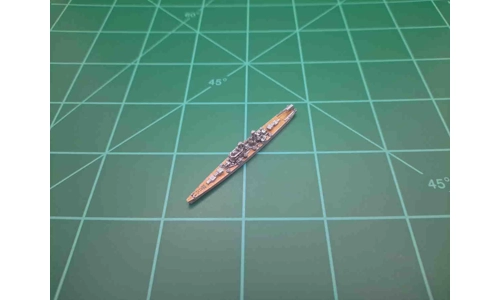
Cleveland Class Light Cruiser
Product Details
- Cleveland Class Light Cruiser
- CL-CLEVELAND-EM-P
-
- Units in Stock: 5
Cleveland Class Light Cruiser Summary
3D Print Cleveland Class Light CruiserAn alternative to out of the box Axis and Allies pieces, 3D print opens a new world of customized pieces, where basically any historical ship can be obtained. We use 3D printed game pieces regularly to enhance the realism of our fleet and also to use as equipment upgrade paths during the game.
These 3D designs by EBard offer exceptional detail and combined with our custom painting and decal graphics, make these ships simply the finest 3D printed game pieces available. These are guaranteed to become the most prized pieces in your collection.
The Cleveland class light cruisers was the largest class of light cruisers ever built. These were based on the preceding Brooklyn-class cruiser design. The ships were designed with the goal of increased cruising range, anti-aircraft armament and torpedo protection compared with earlier U.S. cruisers.
After the London Naval Treaty of 1930 passed, the US Navy took up a renewed interest in the 6" gun armed light cruiser, partially due to the fleet complaining about the 8" gun's slow rate of fire of 3 rounds per minute compared to 10 rounds per minute achieved by 6" guns. At this time, the US Navy began to deploy drones to use as targets for anti-aircraft targets, which could simulate both dive and torpedo bombers. The results were dismaying to the fleet, as the simulations showed that without fire control directors and computers, the ships of the fleet would be almost helpless against the density of aircraft attack they envisioned the future war bringing. The mechanical computers alone could weigh up to 10 tons and had to be housed below decks for both weight and protection measures. As World War II was to prove, the assumptions made pre-war were optimistic. Eventually, every anti-aircraft gun platform above 20mm would end up moving to remote power and aiming with associated fire control and radar.
As designed the Cleveland class was already a narrow design but requests to widen the ship were turned down because it would affect production rates. In order to fit the new heavier fire control and radar systems within the allotted tonnage for a cruiser, the No. 3 gun turret was omitted. This also gave room for the enlargement of the bridge spaces to accommodate the new combat information center and the necessary radars, along with enough tonnage to fit an additional pair of 5"/38 twin mounts, which were located fore and aft of the superstructure, granting wider arcs of fire. Despite the loss of three 6-inch guns compared to the proceeding Brooklyn and St. Louis-class cruisers, the new, more advanced fire control gave the Cleveland-class ships a firepower advantage in practical use.
Later increases of light anti-aircraft artillery made the class top-heavy towards the end of World War II. The top weight issues forced something to be removed for every addition made. For instance, to compensate for the weight increase, some ships had one catapult removed, along with the rangefinders from the No. 1 turret.
Fifty-two ships of this class were originally planned, but nine of them were completed as the light aircraft carriers of the Independence class, and two of them were completed to a somewhat different design, with more compact superstructures and just a single stack. These two were called the Fargo class. Of the 27 Cleveland-class cruisers that were commissioned, one (Galveston) was completed as a guided missile cruiser and five were later modified as Galveston and Providence-class guided missile cruisers. Two of each of the guided missile cruiser-classes had enlarged superstructures to serve as flagships. Following the naming convention at the time, all the ships completed as cruisers were named for US cities and towns.
The Clevelands served mainly in the Pacific Fleet during World War II, especially in the Fast Carrier Task Force. All of these warships survived the war and six were later finished as or converted to guided missile cruisers, and these served into the late 1970s. None were recommissioned for the Korean War, as they required a crew almost as large as the Baltimore-class ships, and those ships were reactivated instead.
Ships of Class:
- CL-55 Cleveland
- CL-56 Columbia
- CL-57 Montpelier
- CL-58 Denver
- CL-59 Amsterdam
- CL-60 Santa Fe
- CL-61 Tallahassee
- CL-62 Birmingham
- CL-63 Mobile
- CL-64 Vincennes
- CL-65 Pasadena
- CL-66 Springfield
- CL-67 Topeka
- CL-76 New Haven
- CL-77 Huntington
- CL-78 Dayton
- CL-79 Wilmington
- CL-80 Biloxi
- CL-81 Houston
- CL-82 Providence
- CL-83 Manchester
- CL-84 Buffalo
- CL-85 Fargo
- CL-86 Vicksburg
- CL-87 Duluth
- CL-88 Newark
- CL-89 Miami
- CL-90 Astoria
- CL-91 Oklahoma City
- CL-92 Little Rock
- CL-93 Galveston
- CL-94 Youngstown
- CL-99 Buffalo
- CL-100 Newark
- CL-101 Amsterdam
- CL-102 Portsmouth
- CL-103 Wilkes-Barre
- CL-104 Atlanta
- CL-105 Dayton

Updating Order Details
Please do not refresh or navigate away from the page!
Customer Reviews
No Reviews Posted Yet - be the first!
(write review)


